In this edition:
- Registration Continues for the 42nd Annual AMSAT Space Symposium & Annual General Meeting
- AMSAT 2024 Space Symposium Call for Papers – A Reminder
- One Week Remaining to Vote in AMSAT Board of Directors Election
- AMSAT 2024 President’s Club Membership Raises over $36,000 To-Date
- FUNcube Data Warehouse Back Online
- AMSAT-DL ERMINAZ Mission Postponed to 2025
- Updated Software Available for NOAA Polar and Russian Meteor Weather Satellites
- VUCC Satellite Standing September 2024
- Changes to AMSAT TLE Distribution for September 6, 2024
- ARISS News
- Upcoming Satellite Operations
- AMSAT Ambassador Activities
- Satellite Shorts From All Over
The AMSAT News Service bulletins are a free, weekly news and information service of AMSAT, the Radio Amateur Satellite Corporation. ANS publishes news related to Amateur Radio in Space including reports on the activities of a worldwide group of Amateur Radio operators who share an active interest in designing, building, launching and communicating through analog and digital Amateur Radio satellites.
The news feed on http://www.amsat.org publishes news of Amateur Radio in Space as soon as our volunteers can post it.
Please send any amateur satellite news or reports to: ans-editor [at] amsat [dot] org.
You can sign up for free e-mail delivery of the AMSAT News Service Bulletins via the ANS List; to join this list see: https://mailman.amsat.org/postorius/lists/ans.amsat.org/
ANS-252 AMSAT News Service Weekly Bulletins
To: All RADIO AMATEURS
From: Radio Amateur Satellite Corporation
712 H Street NE, Suite 1653
Washington, DC 20002
DATE 2024 SEP 08
Registration Continues for the 42nd Annual AMSAT Space Symposium & Annual General Meeting
The 42nd Annual AMSAT Space Symposium and Annual General Meeting will be held on Friday through Saturday, October 25-26, 2024, at the DoubleTree by Hilton Tampa Rocky Point Waterfront in Tampa, Florida.

Highlights of all scheduled events include:
AMSAT Board of Directors Meeting, October 24-25
42nd AMSAT Space Symposium and Annual General Meeting, October 25-26
Friday Night Social and Auction, October 25
AMSAT Banquet and Reception, October 26
AMSAT Ambassador Breakfast (all are welcome), October 27
The complete schedule and registration information can be found at https://launch.amsat.org/event-5833792.
IMPORTANT: The deadline for Symposium registrations if you want to include the Saturday evening banquet or Sunday breakfast is Friday, October 18th. Meals cannot be ordered after that date.
Hotel Reservations
The rate for a standard room with two Queen beds is $169.00 plus state and local taxes of 14.5%. Rooms may be available for check-in on Wednesday, October 23 and check out Sunday, October 27. Note: If you are planning on driving to the Symposium or renting a car, parking charges are $20 per night for overnight parking.
Rooms can be reserved at https://www.hilton.com/en/attend-my-event/radioamateursatellite/. Reservations may also be made by phone at 813-888-8800. Reference AMSAT to receive the group rate.
AMSAT is excited to be able to host its 42nd annual Symposium this year. They hope that you can join us in celebrating Amateur Radio in Space.
[ANS thanks AMSAT for the above information.]
The 2024 AMSAT President’s Club coins are here now!
Help Support GOLF and Fox Plus
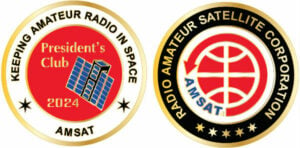
Join the AMSAT President’s Club today and help
Keep Amateur Radio in Space!
https://www.amsat.org/join-the-amsat-presidents-club/
AMSAT 2024 Space Symposium Call for Papers – A Reminder
This is a reminder for the first call for papers for the 42nd annual AMSAT Space Symposium to be held on the weekend of October 25-27, 2024 at the Doubletree by Hilton Tampa Rocky Point Waterfront in Tampa, Florida.
Proposals for symposium papers and presentations are invited on any topic of interest to the amateur satellite community. We request a tentative title of your presentation as soon as possible, with final copy submitted by October 18 for inclusion in the symposium proceedings. Abstracts and papers should be sent to Dan Schultz, N8FGV at n8fgv [at] usa [dot]net.
[ANS thanks Dan Schultz, N8FGV, AMSAT Symposium Proceedings Editor for the above information]
One Week Remaining to Vote in AMSAT Board of Directors Election – LAST CALL
Voting for this year’s Board of Directors election ends on September 15, 2014. If you are an AMSAT member and have not already voted, you are encouraged to exercise your voting right and participate in this election.
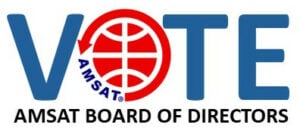
If you have lost your ballot, no worry, you can still vote! Simply log into the membership portal at https://launch.amsat.org/Sys/Login then click on the “2024 BOARD OF DIRECTORS ELECTION” tab and vote. Candidate statements are included with your ballot. Duly nominated candidates, listed in alphabetical order are:
Mark Hammond, N8MH
Frank Karnauskas, N1UW
Bruce Paige, KK5DO
Paul Stoetzer, N8HM
Douglas Tabor, N6UA
As three seats on the Board of Directors are up for election this year, the three candidates receiving the largest number of votes shall be declared elected to the seats. The two candidates receiving the next largest number of votes shall be declared First Alternate and Second Alternate, respectively. The voting period is now open and shall conclude on September 15, 2024. Results will be announced no later than September 30, 2024.
[ANS thanks Jeff Davis, KE9V, AMSAT Secretary for the above information]
Need new satellite antennas?
Purchase M2 LEO-Packs from the AMSAT Store.

When you purchase through AMSAT, a portion of the proceeds goes towards
Keeping Amateur Radio in Space.
https://amsat.org/product-category/hardware/
AMSAT 2024 President’s Club Membership Raise over $36,000 To-Date
AMSAT would like to recognize those members whose generous gifts to the AMSAT 2024 President’s Club help move its educational and engineering programs to fulfillment. President’s Club members have contributed over $36,000 to-date during the 2024 year. Frank Karnauskas, N1UW, AMSAT VP-Development comments, “It’s really gratifying to see AMSAT membership continue to support AMSAT projects during what some people consider to be ‘quiet years’ – those years following the retirement of some of our most popular satellites and the year or so before our next family of satellites are flight ready.
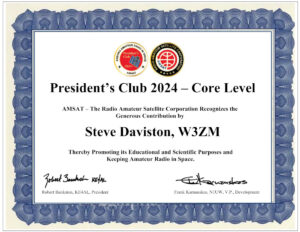
“In fact, things are far from quiet. AMSAT engineering teams for both Fox-Plus and the Golf-Tee are moving quickly so the wait for a new family of birds won’t be all that long. The ASCENT engineering team is also charging ahead with new payloads for packet and SSTV operation. And, to keep AMSAT in the game as satellite licensing becomes more strict, work on propulsion systems for CubeSat-class vehicles is benefitting from the experience of a fresh team of experienced aerospace engineers. A lot is happening behind the scenes.”
AMSAT is pleased to recognize the following President’s Club members who have contributed to date:
Titanium ($4,800+)
Barry Baines, WD4ASW
Alan Biddle, WA4SCA
Williamm Brown, K9LF
Platinum ($2,400+)
Ray Crafton, KN2K
Quarter Century Wireless Association
Gold ($1,200+)
Anonymous
Burns Fisher, WB1FJ
Mark Hammond, N8MH
John Kludt, K7SYS
Glenn Miller, AA5PK
Silver ($600+)
Donald Coker, KM6TRZ
Richard Dittmer, KB7SAT
Warren Fugate, W3WE
Mark Johns, K0JM
Joseph, Lynch,N6CL
Bruce Paige, KK5DO
Peter Prendergast, W2PP
Jason Schwarz, N4JJS
Bronze ($300+)
Keith Baker, KB1SF
Edward Krome, K9EK
Donald Pettigrew, K9ECT
Dave Taylor, W8AAS
Core ($120+)
Oscar Alonzo, N6PAZ
David Batzle, N2VDY
Robert Beatty, WB4SON
Alan Boggs, K7IIV
James Gallagher III, KB3SQS
George Gallis, AL7BX
David Hartrum, WA3YDZ
Steven Husey, KB1UOJ
Doug Papay, K8DP
William Pesci, N4WLP
Martin Shinko, KB3AEV
Paul Stoetzer, N8HM
Owen Trott, KF5BLK
Stefan Wagener, VE4SW
Wayne Wagner, AG1A
Persons interested in joining this elite group of donors can join either through the AMSAT Store at https://www.amsat.org/product-category/amsat-presidents-club-donations/ or by making a donation via the membership portal. Anyone with questions or comments on joining the President’s Club or donating in general are asked to contact Frank at f.karnauskas [at] amsat [dot] org.
[ANS thanks Frank Karnauskas, N1UW, AMSAT VP-Development for the above information.]
FUNcube Data Warehouse Back Online
Dave Johnson, G4DPZ, reports, “The FUNcube Data Warehouse is now successfully ingesting packets from the FUNcube Dashboards. We are now successfully storing real time, whole orbit data and fitter messages in the warehouse after the move to the new Virtual Machine. The warehouse was shut down on the August 31 and the first packet in the new warehouse was on September 3, during which time we have collected 5382 packets.
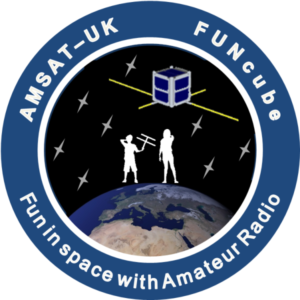
“Our thanks to all those that left their dashboards connected during the outage and our thanks to the following for their assistance in bringing the warehouse back to life:
HB9MFL
KC0BMF
VK5HI
WA7FWF
G4BIP
TUDelft
VK5GU
Goonhilly_Earth_Station
F1GRR
VA3ROM
DF7SC
K4OZS
N8MH
DL9DAK
PA3WEG
N1MIW
JJ1WTK
“If you collected any bin files during the past 5 days they can be uploaded too. If you are still experiencing errors. Please back up the session to a bin file, stop and start the dashboard and load the bin file. Then restart again if the upload works.
“We will continue to work on the UI over the next two days and it is likely that we will restore the ability to download WOD.”
Dave also remarks, “FC1 is now nearly 11 years old and is operating in low power telemetry mode with the transponder, in order to manage the battery capacity.
“We still encourage ground stations to attempt reception of the telemetry. If you have lost your registration details for your ground station please email [email protected] Please watch http://data.funcube.org.uk for updates and the new user interface.”
[ANS thanks Dave Johnson, G4DPZ, on behalf of the FUNcube Team for the above information.]
AMSAT-DL ERMINAZ Mission Postponed to 2025
On Monday evening, August 19, 2024, just a few weeks before the planned launch date of the ERMINAZ payload, Rocket Factory Augsburg (RFA) conducted a “hot fire” test of the first rocket stage at its launch site at SaxaVord Spaceport on the Shetland Islands, during which all 9 engines were ignited. Unfortunately, this resulted in a serious anomaly that led to the complete loss of the first rocket stage. The repair work, fault analysis, qualification and delivery of a new first rocket stage will take some time, so that RFA now officially expects a launch in 2025.
The Erminaz mission is a joint effort between AMSAT-DL, AMSAT-EA and the Libre Space Foundation, with each organization flying its own satellites and jointly using the PicoBus deployer developed by Libre Space in the ERMINAZ mission.
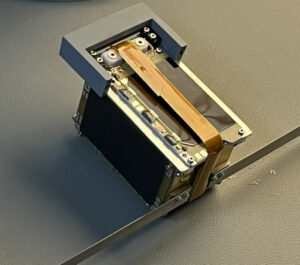
Examples of the payloads include UNNE-1 and MARIA-G 1.5P PocketQubes from AMSAT-EA in Spain. They are both based on the HADES-D (SO-121) hardware currently in orbit and provide a repeater service for voice and data communications in FM and FSK modes. They were developed and built by AMSAT-EA in collaboration with private sector companies and with the participation of universities and educational centers. Both satellites will provide licensed radio amateurs around the world with the ability to conduct FM and FSK QSOs, including FT modes such as FT-4 and FT-8 or AX.25/APRS. The satellites will also transmit telemetry with their status, voice messages and CW. Both satellites have the amateur radio special call sign AM1HAD.
For detailed information on this ambitious and collaborative mission including the capabilities of all the various satellites included in this project, go to https://amsat-dl.org/en/erminaz-mission-postponed-to-2025/.
[ANS thanks AMSAT-DL for the above information.]
Updated Software Available for NOAA Polar and Russian Meteor Weather Satellites
Tracking and downloading images from NOAA Polar and Russian Meteor weather satellites are an excellent way to introduce young persons to the world of amateur satellites and radio communications. True, they are not amateur radio satellites. But, they are loud and always on. Using a SDR dongle costing less than $50, a laptop computer that every kid already owns and free software, youth can get their first taste of tracking a satellite across the sky using a smart phone app, recording a downlink and printing out pictures of their own weather in real time. From there it is a simple jump to listening to voice communications and printing APRS packet conversations from the ISS – another easy-to-hear and predictable source of signals from space.
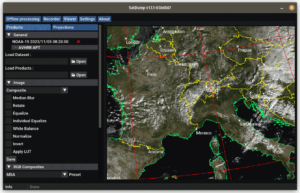
Historically, WXtoIMG has been the software of choice for the popular hobby of decoding NOAA APT weather satellite images with RTL-SDR and other SDRs. However, the software has unfortunately been abandoned by its authors for several years, and can now only be found on third-party websites which increases the possibility of downloading a virus.
Jacopo Cassinis, IU1QPT, author of SatDump, and Robin Slovacek, OK2AWO, for sharing their thoughts about switching to SatDump which now has full feature parity with WXtoIMG and additional features, too. SatDump is available on Windows, MacOS, Linux, and even on Android. Read their comments at https://www.rtl-sdr.com/.
An up-to-date guide for receiving APT pictures with SatDump can be found at https://www.a-centauri.com/articoli/noaa-poes-satellites-reception.
Also available to watch on the rtl-sdr website is a short video on setting up a simple v-dipole for NOAA weather satellite reception with the SDR-Dongle. (The video uses the out-of-date WXtoIMG software but the overall procedure for setting up the station is usable.) If you need to get more ideas on weather satellite picture reception, just go to YouTube and search “NOAA weather satellite reception” and be prepared to watch several hours worth of useful videos.
Copying NOAA weather satellites is easy to do and a fun way to introduce youngsters to space communications. It could be the first step to getting that Technician ticket!
[ANS thanks rtl-sdr.com and AMSAT for the above information.]
VUCC Satellite Standing September 2024
VUCC Satellite Award/Endorsement Change Summary for August 01, 2024 to September 01, 2024.
| CALL | Aug | Sept |
|---|---|---|
| WC7V | 1575 | 1611 |
| DL5GAC | 1413 | 1576 |
| DL2GRC | 1426 | 1501 |
| N8RO | 1461 | 1490 |
| N9EAT | 1029 | 1127 |
| K9UO | 1001 | 1030 |
| EA2AA | 954 | 982 |
| KQ4DO | 906 | 952 |
| JL1SAM | 804 | 905 |
| JG6CDH | 734 | 777 |
| HB9AOF | 725 | 743 |
| KC4CJ | 650 | 702 |
| N3CAL | 653 | 686 |
| IK7FMQ | 626 | 651 |
| SA0UNX | New | 617 |
| N5EKO | 581 | 599 |
| KH6WI | 400 | 530 |
| N9ZTS | 400 | 501 |
| PA7RA | 409 | 495 |
| N8URE (FM19) | 430 | 450 |
| W9FF | 400 | 450 |
| JI5USJ | 355 | 425 |
| W3VHF | 250 | 406 |
| JO4JKL | 188 | 401 |
| N8HRZ | 298 | 337 |
| W0PR | 276 | 327 |
| N4QWF | 255 | 325 |
| AA0K | 200 | 253 |
| DF5SF | New | 217 |
| 9A2GA | New | 202 |
| NK0S | 167 | 169 |
| XE2/CO6LAR | New | 129 |
| NC0Q | New | 108 |
| AE5AU | New | 101 |
| 4A2MAX | New | 100 |
Congratulations to the new VUCC Satellite holders.
NC0Q is first VUCC Satellite holder from EN11
9A2GA is first VUCC Satellite holder from JN75
DXCC Satellite has still not been updated since May
[ANS thanks Jon Goering, N7AZ, for the above information.]
Want to fly the colors on your own grid expedition?
Get your AMSAT car flag and other neat stuff from our Zazzle store!
25% of the purchase price of each product goes towards
Keeping Amateur Radio in Space
https://www.zazzle.com/amsat_gear
Changes to AMSAT TLE Distribution for September 6, 2024
Two Line Elements or TLEs, often referred to as Keplerian elements or keps in the amateur community, are the inputs to the SGP4 standard mathematical model of spacecraft orbits used by most amateur tracking programs. Weekly updates are completely adequate for most amateur satellites. TLE bulletin files are updated daily in the first hour of the UTC day. New bulletin files will be posted immediately after reliable elements become available for new amateur satellites. More information may be found at https://www.amsat.org/keplerian-elements-resources/.
- The following satellite has been removed from this week’s AMSAT TLE distribution:
RoseyCubesat 1 NORAD Cat ID 56212 Decayed from orbit on or about 01 September 2024
- The following satellite has been added to this week’s AMSAT TLE distribution:
SR-0 DemoSAT NORAD Cat ID 60455 IARU coordinated downlink 437.400 MHZ 9k6 FSK AX25 , 4FSK SSDV and 38k4 LoRa
CosmoGirlSat NORAD Cat ID60953 IARU coordinated downlink 437.120 MHz and 145 825 MHz
Sakura NORAD Cat ID 60954 IARU coordinated downlink 145.825 MHz and 437.375 MHz
Binar 2 NORAD Cat ID 60956 IARU coordinated downlink 437.700 MHz
Binar 3 NORAD Cat ID 60957 IARU coordinated downlink 437.850 MHz
Binar 4 NORAD Cat ID 60952 IARU coordinated downlink 437.925 MHz
[ANS thanks Joe Fitzgerald, KM1P, AMSAT Orbital Elements Manager, for the above information.]
ARISS NEWS
Amateurs and others around the world may listen in on contacts between amateurs operating in schools and allowing students to interact with astronauts and cosmonauts aboard the International Space Station. The downlink frequency on which to listen is 145.800 MHz worldwide.

- Upcoming Contacts
Instituto de Aplicacao Fernando Rodrigues da Silveira (CAp-UERJ) and The State University of Rio de Janeiro (UERJ), Rio de Janeiro, Brazil, direct via PY1AX.
The ISS callsign is presently scheduled to be NA1SS.
The scheduled crewmember is Sunita Williams, KD5PLB.
The ARISS mentor is Steven McFarlane, VE3TBD.
Contact is go for Friday, September 13, 2024 at 17:25:47 UTC.
The crossband repeater continues to be active (145.990 MHz up {PL 67} & 437.800 MHz down). If any crewmember is so inclined, all they have to do is pick up the microphone, raise the volume up, and talk on the crossband repeater. So give a listen, you just never know.
The packet system is also active (145.825 MHz up & down).
As always, if there is an EVA, a docking, or an undocking; the ARISS radios are turned off as part of the safety protocol.
Note, all times are approximate. It is recommended that you do your own orbital prediction or start listening about 10 minutes before the listed time.
The latest information on the operation mode can be found at https://www.ariss.org/current-status-of-iss-stations.html
The latest list of frequencies in use can be found at https://www.ariss.org/contact-the-iss.html
[ANS thanks Charlie Sufana, AJ9N, one of the ARISS operation team mentors for the above information.]
Upcoming Satellite Operations
No operations are currently listed.
A growing number of satellite rovers are currently engaged in sharing their grid square activations on https://hams.at. By visiting the website, you gain easy access to comprehensive information about the operators responsible for activating specific grid squares. Additionally, you have the ability to assess the match score between yourself and a particular rover for a given pass, while also being able to identify the upcoming satellite passes that are accessible from your location.
[ANS thanks Ian Parsons, K5ZM, AMSAT Rover Page Manager, and Alex Ners, K6VHF, for the above information.]
AMSAT Ambassador Activities
AMSAT Ambassadors provide presentations, demonstrate communicating through amateur satellites, and host information tables at club meetings, hamfests, conventions, maker faires, and other events.
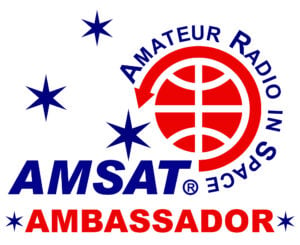
October 5, 2024
North Star Radio Convention
Hennepin Technical College (North Campus)
Brooklyn Park, MN.
https://conv2023.tcfmc.org/
AMSAT Forum and Information Table
KØJM and ADØHJ
October 5, 2024
Central Kentucky Hamfest
Highlands Baptist Church
2032 Parallel Road
Lexington, KY 40502
https://www.facebook.com/w9khz/
AMSAT and Educational Satellites Forum and Information Table
AI4SR and W4FCL
October 5, 2024
Radio Society of Tucson
Calvary Tucson Church
7811 E. Speedway
Tucson, AZ
https://k7rst.club/2024/07/tucson-autumn-ham-fest-2024/
N1UW
October 18-20, 2024
Pacificon 2024, ARRL Pacific Division Conference
San Ramon, CA
WUØI
https://www.pacificon.org/
October 25-27, 2004
AMSAT Space Symposium and Annual General Meeting
Double Tree Rocky Point Waterfront Hotel
Tampa Bay, FL
https://www.amsat.org/2024-symposium/
November 2-3, 2024
Stone Mountain Hamfest, ARRL State Convention
Stone Mountain, GA
K4RGK
November 9, 2024
Oro Valley Amateur Radio Club
Marana Middle School
11285 West Grier Rd.
Marana, AZ 85653
https://www.tucsonhamradio.org/copy-of-hamfest-2022
N1UW
February 20-22, 2025
Yuma HAMCON
Yuma, AZ
N1UW
Interested in becoming an AMSAT Ambassador? AMSAT Ambassadors provide presentations, demonstrate communicating through amateur satellites, and host information tables at club meetings, hamfests, conventions, maker faires, and other events.
For more information go to: https://www.amsat.org/ambassador/
[ANS thanks Bo Lowrey, W4FCL, Director – AMSAT Ambassador Program for the above information.]
Satellite Shorts From All Over
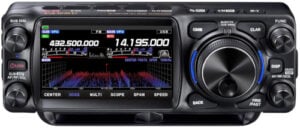
- Yaesu has announced the upcoming FTX-1F HF/6/144/440 portable transceiver, presumably a replacement for the FT-816/817 series of transceivers that were very popular among satellite operators. The transceiver is said to have two independent SDR receivers that provide simultaneous dual-band operation, whether in the same or in different bands. (Editor’s note: This does not necessarily mean that the transceiver will operate in full duplex mode.) It will provide 6W of power output with the included 5670mAh Lithium-ion battery pack or up to 10W with external power. Average CW/SSB operating time in the VHF/UHF bands is quoted as up to 8 hours. SSB, CW, AM, FM and C4FM operation is available. USB ports support CAT operation, audio input/output and TX control. The FTX-1F has not been formally been released for sale in the United States but should be available early 2025. [ANS thanks Yaesu for the above information.]
- JAXA officially ended the mission of SLIM, the country’s first Moon lander, last week. Originally only expected to operate for a single lunar day and then feared to be doomed after it landed in the incorrect orientation after losing an engine bell, the mission managed to survive 3 lunar nights and complete all pre-mission success criteria. SLIM is the first lunar lander to successfully perform a “pinpoint” landing, arriving within 10 meters of its selected landing site. [ANS thanks The Orbital Index for the above information.]
- The average age of a GPS satellite is now 13 years, with half of them exceeding their designed lifespan. The USA-132 satellite broke the record for the oldest GPS satellite in history, having completed 27+ years in operation. While the record is an indicator of the reliability and robust engineering of the GPS satellite, it also means that the service still relies on hardware built in the 1990s. 31 GPS satellites are in operation today, down from 36 in 2016. The GPS system was primarily designed for military purposes but was opened up to wide-scale civilian use in 1983. Since then, GPS has grown into one of the most widely used services in the world, with billions of people using GPS on a daily basis today. The overall GPS network still works well. But the aging satellites, coupled with the delays in the launch schedule for new satellites, threaten its competitive edge as international rivals bring into service their own GNSS systems and private companies develop alternatives. (ANS thanks PayloadSpace.com for the above information. Fact-filled full article available at: https://payloadspace.com/rise-and-stall-of-gps-the-average-age-of-gps-satellites-hits-13-years/.
Join AMSAT today at https://launch.amsat.org/
In addition to regular membership, AMSAT offers membership to:
- Societies (a recognized group, clubs or organization).
- Primary and secondary school students are eligible for membership at one-half the standard yearly rate.
- Post-secondary school students enrolled in at least half time status shall be eligible for the student rate for a maximum of 6 post-secondary years in this status.
- Memberships are available for annual and lifetime terms.
Contact info [at] amsat [dot] org for additional membership information.
73 and remember to help Keep Amateur Radio in Space!
This week’s ANS Editor, Frank Karnauskas, N1UW
f.karnauskas [at] amsat [dot] org
